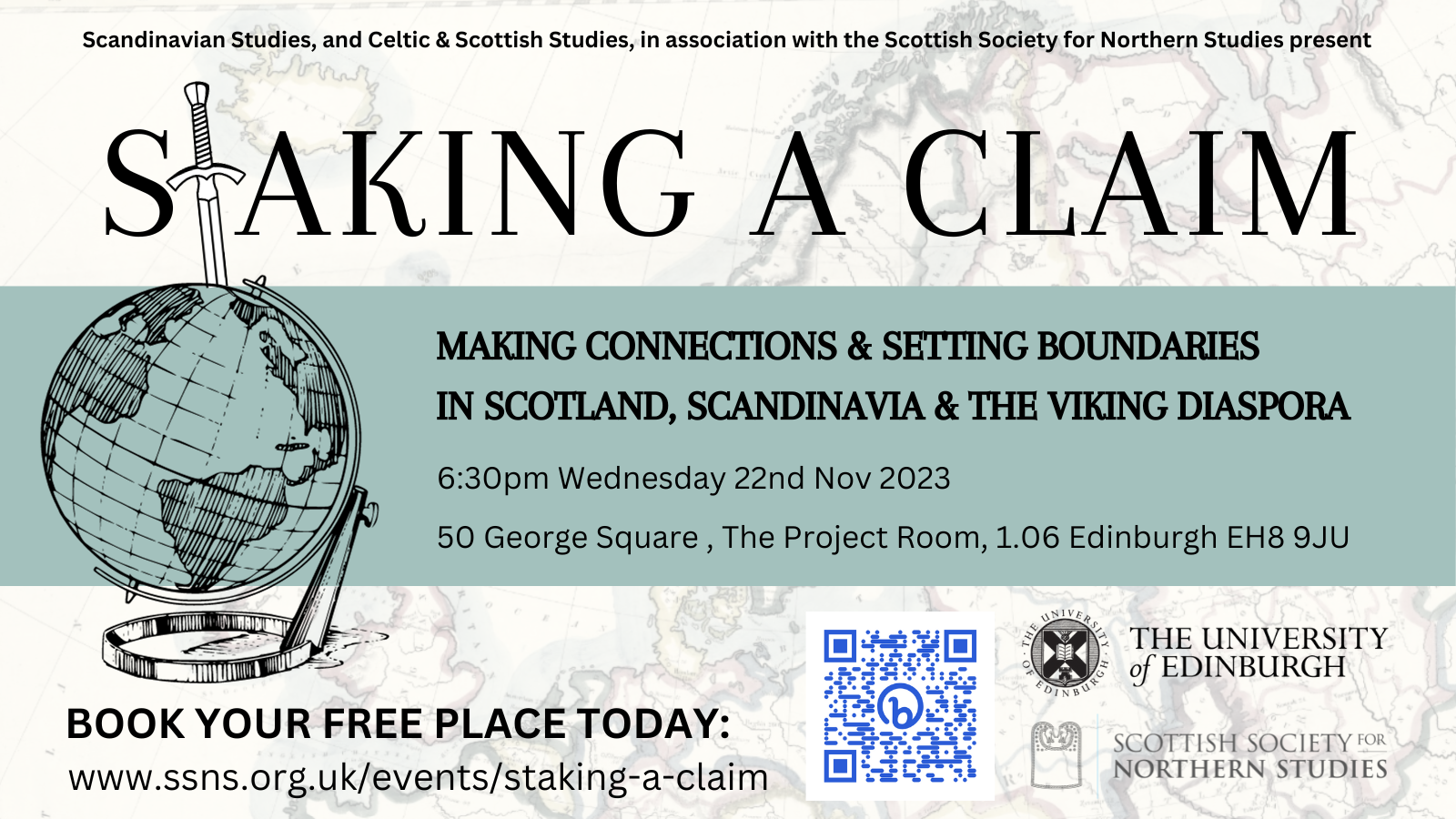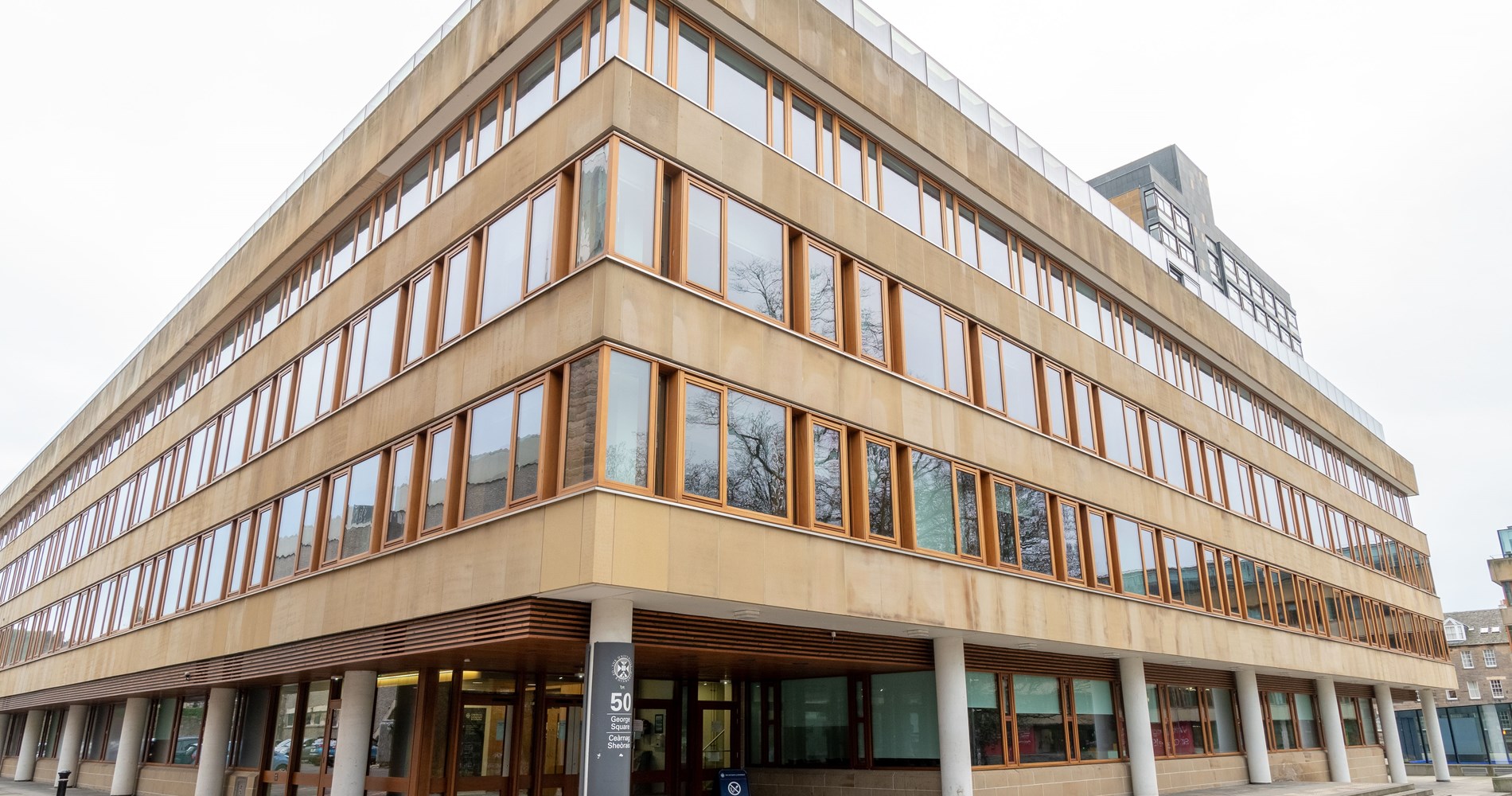Staking a Claim: Making Connections and Setting Boundaries in Scotland, Scandinavia and the Viking Diaspora
 Join us on Wednesday 22nd November 2023 for Staking a Claim: an evening event where speakers will explore notions of Making Connections and Setting Boundaries in Scotland, Scandinavia and the Viking Diaspora.
Join us on Wednesday 22nd November 2023 for Staking a Claim: an evening event where speakers will explore notions of Making Connections and Setting Boundaries in Scotland, Scandinavia and the Viking Diaspora.
Hosted by the departments of Celtic & Scottish Studies and Scandinavian Studies at the University of Edinburgh in partnership with the Scottish Society for Northern Studies; the event will feature the Society’s annual Hermann Pálsson Memorial Lecture.
Attendance is free and will include light refreshments.
Programme:
18:30 | Coffee
18:50 | Dr Alan Macniven, University of Edinburgh
Welcome
19:00 | Dr Margaret Mackay, University of Edinburgh
Scottish Ethnology and Scandinavian Studies at Edinburgh: A Creative Continuum
19:30 | The Hermann Pálsson Memorial Lecture: Prof. Terry Gunnell, University of Iceland
Floating High Seat Pillars and the Settlement of Iceland: Fact, Fake News or Folklore?
20:30 | Mingle, fin
Speaker bios and abstracts (click on the speaker’s name to expand)
Margaret Mackay
Dr Margaret Mackay was born in Regina, Saskatchewan, Canada, and came to the University of Edinburgh in 1967 upon graduation from the University of Toronto. Here she gained a Postgraduate Diploma in Scottish Studies and a PhD. Her dissertation was on the alliterative tradition in Middle Scots poetry. Appointed to the School of Scottish Studies, first as a Research Associate and then Lecturer and Senior Lecturer, she became its Director and Director of its Archives before retirement. She is still an Honorary Fellow in Celtic & Scottish Studies, and a Past President of the Scottish Society for Northern Studies. She was recently appointed an Honorary President of The Saltire Society.
Abstract: The proposal to create a Department of Scandinavian Studies in the Faculty of Arts at the University of Edinburgh in 1987 was greeted with great enthusiasm and nowhere more so than in its School of Scottish Studies. Historical links between the two culture areas have been evident from the Middle Ages to the Shetland Boats of World War II, while scholarly connections through the centuries bring to mind immediately names such as Grímur Thorkelin (1752-1829), Gaelic manuscript collector, and John Francis Campbell of Islay (1821-1885), folklorist, traveller, scientist, artist.But the School itself had Scandinavia in its DNA. It was founded in the academic session 1950-51, through the vision of Professor Angus McIntosh and those who encouraged him, including Professor James Hamilton Delargy, Director of the Irish Folklore Commission, who in turn readily acknowledged the model and the practical support given to him by Sweden and its folklorists. A School of Scottish Studies might well have come into being in the 1930s, through initiatives of the newly-founded Scottish Anthropological and Folklore Society, who had itself turned to Ireland and through Ireland to Sweden, for guidance and input. Professors Dag Stromback and Åke Campbell of Uppsala were mentors then and again in the 1950s, following the hiatus in the Society’s activities caused by World War II. From its inception, the School of Scottish Studies reached out to the wider world of European Ethnology and beyond, acquiring library monographs and journal subscriptions from Scandinavian institutions. Its first full-time oral narrative collector, Calum Maclean, was sent to Uppsala for training in fieldwork techniques and archival classification. The system instituted by the School for its sound and other collections was that developed at the Uppsala Folklore and Dialect Archive, adapted for Scottish purposes. The School of Scottish Studies helped to form the University of Edinburgh’s Northern Scholars Scheme in the 1950s. The Scottish Society for Northern Studies and its programmes of talks, study visits and publications, received input from School staff and students from its creation in 1968, as did the Scottish Place-Name Society (1996), with its interest in name elements derived from Old Norse.The 1980s saw the introduction of full undergraduate degrees, single and joint honours, in Scottish Ethnology, with Scandinavian Studies as a most welcome colleague for these. A School programme in the 1990s of Visiting Distinguished Professors of Ethnology brought scholars from Denmark, Sweden and Norway to contribute to teaching and research supervision. Such creative co-operation has been maintained since at all levels and will continue to do so.
Terry Gunnell
Terry Gunnell is Professor of Folkloristics at the University of Iceland. Author of The Origins of Drama in Scandinavia (1995), he is editor of Masks and Mumming in the Nordic Area (2007), Legends and Landscape (2008), and Grimm Ripples: The Legacy of the Grimms’ Deutsche Sagen in Northern Europe (2022), and co-editor of The Nordic Apocalypse: Approaches to Völuspá and Nordic Days of Judgement (2013) and Málarinn og menningarsköpun: Sigurður Guðmundsson og Kvöldfélagið 1858–1874 which was nominated for the Icelandic Literature Award in 2017.
Abstract: In this paper, I will be returning to the question of whether there was any truth behind the legends of Icelandic settlers throwing their high seat pillars (or even their grandparents) into the sea when approaching Iceland to decide where to they should set up their farms. In recent years, with some logic, historians and some literary scholars have questioned this practice. To the best of my knowledge, hardly anyone has considered the widespread parallels in folk legends across northern Norway and Sweden (also on the Baltic) which talk of very similar practices relating to deciding sites for medieval churches. These suggest that the practice (like that of letting animals decide where people should live) actually seems to have had deep roots in the Nordic countries. The lecture will discuss these legends (along with their distribution), and proceed to link them to other potentially associated beliefs and practices (such as those relating to lot-casting), and foundation myths such as that of Askr and Embla).


